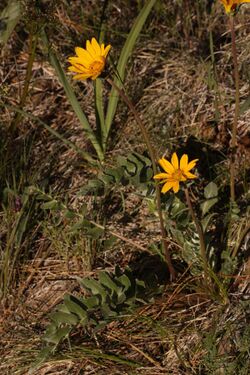Biology:Balsamorhiza sericea
| Balsamorhiza sericea | |
|---|---|

| |
| Scientific classification | |
| Kingdom: | Plantae |
| Clade: | Tracheophytes |
| Clade: | Angiosperms |
| Clade: | Eudicots |
| Clade: | Asterids |
| Order: | Asterales |
| Family: | Asteraceae |
| Genus: | Balsamorhiza |
| Species: | B. sericea
|
| Binomial name | |
| Balsamorhiza sericea W.A.Weber
| |
Balsamorhiza sericea is a species of flowering plant in the tribe Heliantheae of the family Asteraceae known by the common name silky balsamroot. It is native to the Klamath Mountains of northwestern California and southwestern Oregon, with additional populations in the Blue and Steens Mountains in eastern Oregon.[1] It grows in rocky areas, sometimes on serpentine soils.[2]
Description
Balsamorhiza sericea is a taprooted perennial herb growing erect 20 to 40 centimeters (8-16 inches) tall. The leaves are mostly located at the base of the plant. They are vaguely fern-like, with each leaf being composed of many pairs of oppositely-arranged lobes. Each lobe is oval and coated in silvery hairs.[3]
The inflorescence bears a single flower head with a center of yellow disc florets and a fringe of yellow ray florets each 2 or 3 centimeters long. The fruit is an achene just over half a centimeter long.[4]
References
- ↑ "Balsamorhiza sericea", County-level distribution map from the North American Plant Atlas (NAPA) (Biota of North America Program (BONAP)), 2014, http://bonap.net/MapGallery/County/Balsamorhiza%20sericea.png
- ↑ "Balsamorhiza sericea", Calflora: Information on California plants for education, research and conservation, with data contributed by public and private institutions and individuals, including the Consortium of California Herbaria, Berkeley, California: The Calflora Database, https://www.calflora.org/cgi-bin/species_query.cgi?where-taxon=Balsamorhiza+sericea
- ↑ Weber, William A. (2006), "Balsamorhiza sericea", in Flora of North America Editorial Committee, Flora of North America North of Mexico (FNA), 21, New York and Oxford, http://www.efloras.org/florataxon.aspx?flora_id=1&taxon_id=250066216
- ↑ Weber, William Alfred 1982. Phytologia 50(5): 357–359
External links
Wikidata ☰ Q4852558 entry
 |

